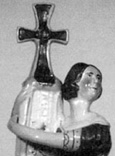The Jenny Lind ExhibitThe Lost Museum Archive

In September 1850, P. T. Barnum embarked on a nationwide tour with a Swedish opera singer that would bring him a vast fortune and create a new cultural phenomenon: the celebrity. Barnum succeeded in building such great public anticipation about the "Swedish Nightingale" that 40,000 people showed up to greet the arrival of her ship in New York harbor. From her opening concert in New York Citys Castle Garden to subsequent performances in cities and towns across the country, Barnum fueled public fascination with Lind by orchestrating events and negotiating Lind-endorsed products (including Jenny Lind songs, clothes, chairs, and pianos). "Lindomania" lasted until 1852, when the partnership collapsed over logistical and financial issues. Barnum shrewdly promoted Lind’s character--her modesty, benevolence, and selflessness--as much as her artistry. One scholar contends that because of Barnum’s promotion, Lind became "the standard for measuring not just sopranos, or even women artists, but women" throughout the 1850s.